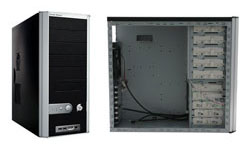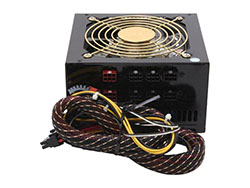Pre-AM2 Mid-Range Buyers' Guide, May 2006
by Jarred Walton on May 9, 2006 6:30 AM EST- Posted in
- Guides
Case and Power Supply
You can choose a case merely for functionality, or your case can make an aesthetic statement. If you don't like our case choice, you're more than welcome to choose something that you do like. The only comment we have is that we like cases that have 120 mm fans, as they tend to be a bit quieter overall. Of course, a high RPM 120mm fan certainly isn't going to be quiet, but you can usually get lower RPM 120mm fans that still move more air than a high RPM 80mm fan.For the power supply, we're going with a separate PSU rather than a case with one included. For the midrange sector, quality takes precedence over price, and bundled power supplies usually are pretty mediocre in terms of quality. They might still be sufficient, especially for a system that's not loaded up with lots of extras, but they will be noisier and less robust. That said, I haven't had a power supply fail in over 18 months, and that includes a couple of junk power supplies that came with $40 cases. If you don't have one, picking up a power meter like the Kill-A-Watt device isn't a bad idea. Even a cheap 400W power supply will often be fine for a long time if your system never draws more than 200W.
 |
| Click to enlarge |
Case Recommendation: Cooler Master Centurion 5 CAC-T05-UW
Price: $61 shipped (Retail)
The Cooler Master Centurion 5 is a decent mid-tower ATX case. You get more external 5.25" bays than you need (5), one external 3.5" bay, and 4 internal 3.5" bays. The case is relatively attractive, and it comes with a tool-less drive mounting mechanism for all the drive bays. It also includes a 120mm rear fan, and you can add an optional 80mm front fan. The case is also available with a side window if you want to spend an extra $10. Finally, the case has front USB, FireWire, headphone, and microphone jacks. It's easy to work with, relatively quiet, and well made.
 |
| Click to enlarge |
PSU Recommendation: Enermax Liberty ELT400AWT ATX12V 400W
Price: $86 shipped (Retail)
I'm a big fan of modular power supplies, ever since OCZ released their first ModStream product. (And incidentally, the 450W ModStream is still going strong after a couple years.) Enermax has now joined the crowd of modular power supply manufacturers with their new Liberty line. As with many of the quality power supplies on the market, you might find the 400W rating seems a little low. Realistically, it's difficult to reach anywhere near 400W without multiple ultra high-end graphics cards, multiple hard drives, and a partridge in a pear tree. Unlike generic brand power supplies, the Enermax Liberty should actually be able to sustain 400W of power output, and it's extremely quiet.
I've got a few other modular power supplies around - OCZ, Kingwin, and Sunbeam - and they all work well for my needs. Not surprisingly, they also cost about the same as the Enermax Liberty, and the higher wattage models cost even more. As the old saying goes, you get what you pay for, and we would recommend sticking with power supplies that cost at least $60, unless you're trying to build a budget system. If you're looking at SLI/CrossFire as a potential upgrade, you might also want to bump the PSU up to a 500W or higher rating.










56 Comments
View All Comments
ZJB298 - Wednesday, May 17, 2006 - link
K, so I'm a huge newb, but what's the point of getting or switching to X16 over X8 if there is no performance impact? Is there likely to be more of a performance impact for a gamer or a higher-end graphics card than for a normal user?Basically, is it worth it for me to go searching for another, more expensive motherboard with X16 slots over X8 slots?
JarredWalton - Saturday, May 20, 2006 - link
In my opinion, NO! Dual X16 is just a lot of marketing hype. The board that sport it might benchmark faster at times (by 5% or so), but 5% can be had through BIOS optimizations.Crassus - Tuesday, May 9, 2006 - link
Thanks for a new Buyer's Guide. I wondered when the next one would come for quite some time. It maybe not necessary to bring them as often as when they started, but right now I think they're spaced a wee bit too far apart.It's always a very helpful read and I use it not only as a recommendation of what to buy, but also as an indication of where the industry stands at this time, i.e. what the standard is for any given component. Keep up the good work and (maybe) update them a little more often again.
sabrewulf - Tuesday, May 9, 2006 - link
"Plenty of people are still running old socket 478, 462, and 754 systems, and they're perfectly happy with the level of performance and they have. The latest and greatest computer games almost certainly wouldn't run on those older systems without drastically reducing the graphics quality"754 + PCI-E = perfectly capable of running with maximum eye-candy.
LoneWolf15 - Tuesday, May 9, 2006 - link
And the percentage of Socket 754 mainboards with PCI-E is?Socket 754 performance is decent, but it's truly a dead-end. For hard-core gamers, I'd urge them to get out while they can sell their parts for reasonable cost, much like I'd have said to Socket 423 owners when the P4 switched to 478.
JarredWalton - Tuesday, May 9, 2006 - link
Notice the "OLD" socket 754 part? Obviously, newer 754 PCIe boards are okay. LOL I still do a ton of work on my 754 + 6800GT system, though.sabrewulf - Friday, May 12, 2006 - link
Sorry I guess I didn't notice that word. I'm mostly just speaking up for people like my brother who last year wanted to upgrade his graphics card, but already has a 2.4 ghz 754 chip and couldn't afford a new video card AND an equivalent 939 CPU at the same time, so he got a cheap solid 754 PCI-E board instead. Works great for him, and with AM2 right around the corner, it looks like an even smarter purchase since he can pretty much skip 939 altogether.LoneWolf15 - Tuesday, May 9, 2006 - link
The thought of Socket AM2 didn't excite me, but not just because of the lack of performance. So I think this Upgrade Guide makes a lot of sense (well, at least if you don't need to do a mainboard upgrade at present time).Just the thought of having to completely reload Windows XP was enough to cause me (a month ago) to decide it was better to upgrade to 2GB of DDR and go from a Winchester 3000+ to an Athlon 64 X2 3800+, with no mainboard swap required. My MSI Neo 4 Platinum has been a good board. I plan on getting one year more at the very least out of it before I consider the new platform. I'm sure AM2 is the best option for anyone who still has an Athlon XP (unless they don't wish to save by not swapping out RAM) and that waiting for new Intel hardware is the best solution for anyone who currently has a Socket 478 system or earlier, but now that I have a system board I'm completely happy with, it's really hard to justify an upgrade that would require me to gut the OS...I no longer have that kind of time on a regular basis.
APKasten - Tuesday, May 9, 2006 - link
I find it really hard to believe that 1GB of PC3200, even at low latencies, is worth almost $200. I can get 2 GB at higher latency (4-4-4-7) for about $150! Is the performance boost really worth that much money for just 1 GB? I was always under the impression that more RAM was better than having extra low latency RAM.I took AnandTech's recommendation to get the OCZ EL 512MB (2x256MB) Kit (2.5-3-2-6?) a few years ago. I replaced that with a GeIL 1 GB (2x512MB) kit at 4-4-4-7 last year and I have since had much better performance from my system. That was the only thing I changed on my box. So I guess my real question is, wouldn't 2 GB at higher latencies be better than 1 GB at lower latencies, bang-for-buck-wise?
APKasten - Tuesday, May 9, 2006 - link
Holy crap. Nevermind...I just realized that it was a 2GB kit you were talking about in the article.Sorry. *rolls eyes*